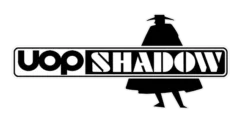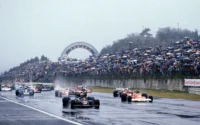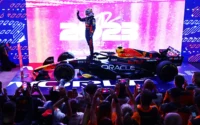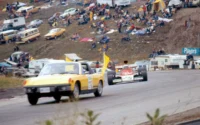Shadow Racing Cars emerged in the late 1960s, characterised by a flair for innovation and a touch of mystery. Shadow made its impact in both sports car racing and Formula One, carving out a place in motorsport history.
The adventure began in 1968 in the United States with CanAm competition, before expanding into Formula One in 1973 with a base in Northampton, England. Interestingly, Shadow managed to become the first team in F1 history to officially “change nationality”, racing under an American licence from 1973 to 1975, then switching to a British one from 1976 to 1980. Their finest F1 moment came in 1977, when Alan Jones powered them to their only Grand Prix victory in Austria.
Fast forward four decades, and the Shadow name roared back to life. In 2020, Italian entrepreneur and racer Bernardo Manfrè reimagined Shadow as a luxury tuning house and race outfit. The reborn Shadow squad competes in the NASCAR Whelen Euro Series as MK1 Racing Italia, fielding the snarling Shadow DNM8 for Claudio Remigio Cappelli, Alfredo de Matteo, Manfrè himself, and Francesco Garisto, with tech support from Race Art Technology.
History
1968–1972: CanAm Beginnings
Shadow Racing Cars sprang from the vision of Don Nichols, who founded Advanced Vehicle Systems in California in 1968. Nichols’ creations, designed by Trevor Harris, were simply called Shadows and ran under the Shadow Racing Inc. banner. Their debut weapon, the Shadow Mk.I, turned heads with its radical small-wheel concept designed for low drag. Fast? Yes. Reliable? Not quite.
By 1969, things escalated. Trevor Harris’ machine gave way to a new Peter Bryant design influenced by his titanium “Ti22” car, while Jackie Oliver joined the team. Results improved — Oliver clinched eighth in the CanAm championship, and backing arrived from Universal Oil Products (UOP).
Shadow hit their stride in the shortened 1974 CanAm season, dominating the field. Granted, the competition wasn’t as fierce; McLaren and Porsche had exited, but the Shadows ruled what was left of the grid.
1973–1974: Formula One Debut
At the end of 1972, Nichols announced Shadow’s move into Formula One. Tony Southgate, the man behind BRM’s Monaco-winning car, designed their new machine with UOP sponsorship.
The DN1 chassis made its F1 debut at the 1973 South African Grand Prix with Oliver and George Follmer at the wheel. Graham Hill’s Embassy Hill team also ran a privateer Shadow alongside the works entries.
In 1974, Shadow signed two rising stars: American ace Peter Revson and French charger Jean-Pierre Jarier. But tragedy struck. Revson was killed during practice at Kyalami when his DN3 suffered suspension failure. He was replaced by Tom Pryce, a gifted Welshman who would soon become synonymous with Shadow.
1975–1977: On the Rise
The Shadow DN5 appeared to be a world-beater in 1975. Jarier stuck it on pole at the first two Grand Prix of the season, only for reliability to betray him in both. Shadow mostly relied on the trusty Ford Cosworth DFV V8, but briefly experimented with a Matra V12-powered DN7. The French engine sounded glorious but proved too costly, and the project was shelved.
Pryce gave Shadow a boost by winning the non-championship Race of Champions in 1975, cementing his reputation. But in 1977, disaster struck again. At the 1977 South African Grand Prix, Pryce was killed in a freak accident involving a track marshal, Frederick Jansen Van Vuuren. The incident remains one of Formula One’s darkest moments.
Yet that same year, Alan Jones replaced Pryce and delivered Shadow’s greatest triumph: victory at the 1977 Austrian Grand Prix, the team’s one and only F1 win.
1978–1980: Decline and Closure
After their peak, Shadow’s fortunes nosedived. Alan Jones departed for Williams in 1978, and much of the team’s technical staff, plus backer Franco Ambrosio, defected to form a new rival: Arrows.
Shadow pressed on with sponsorship from Villiger tobacco and drivers Clay Regazzoni and Hans-Joachim Stuck, but results were lacklustre. By 1979, a youthful pairing of Jan Lammers and Elio de Angelis brought new energy, though only de Angelis managed a single points finish that year. Both left for other teams at the end of the season.
In 1980, Shadow merged into Theodore Racing. Their ground-effect car proved uncompetitive, and despite brief appearances from drivers like Geoff Lees, David Kennedy, and Stefan Johansson, Shadow’s F1 story came to an end mid-season when funds ran dry.
2020–Present: The Revival
Four decades after Shadow’s last F1 lap, the brand was reborn. Bernardo Manfrè reintroduced Shadow as both a high-end tuner and a racing outfit. Plans were teased for an in-house hypercar and a modified Dodge Challenger known as the Shadow DNM8.
On track, Shadow jumped into the NASCAR Whelen Euro Series in 2020 with 42 Racing, running Ford Mustangs for Manfrè, Luigi Ferrara, and Francesco Garisto. The campaign was cut short after COVID-19 struck the team, but in 2021, Shadow returned with the DNM8, the first new Shadow chassis since 1980. Garisto finished a strong fifth in EuroNASCAR 2 that year.
From 2022 onward, Shadow competed under the MK1 Racing Italia name, moving its base to Bollate, Italy. With Manfrè and Garisto continuing, plus new recruits Claudio Remigio Cappelli and Alfredo de Matteo, Shadow now fields two DNM8 cars.
Shadow Racing Cars Inc. Formula One World Championship Records
| First entry | 1973 South African Grand Prix |
|---|---|
| Races entered | 112 |
| Constructors’ Championships | 0 |
| Drivers’ Championships | 0 |
| Race victories | 1 |
| Pole positions | 3 |
| Fastest laps | 2 |
| Final entry | 1980 French Grand Prix |
Shadow Constructors’ Championship Results
Team Names
| Years | Name |
|---|---|
| 1973–1975 | UOP Shadow Racing |
| 1976 | Lucky Strike Shadow Racing |
| 1976 | Tabatip Shadow Racing |
| 1977 | Ambrosio Tabatip Shadow Racing |
| 1978 | Villiger Shadow Racing |
| 1979 | Samson Shadow Racing |
| 1979 | Interscope Shadow Racing |
| 1980 | Shadow Cars |
| 1980 | Theodore Shadow |
As Works
| Year | Chassis | Engine | Tyre | No. | Driver | Rounds | WCC Pts. | WCC Pos. | Report |
|---|---|---|---|---|---|---|---|---|---|
| 1973 | DN1 | Ford Cosworth DFV 3.0 V8 | G | Jackie Oliver | 3–15 | 9 | 8th | Report | |
| George Follmer | 3–15 | ||||||||
| Brian Redman | 15 | ||||||||
| 1974 | DN1 DN3 | Ford Cosworth DFV 3.0 V8 | G | 16 | Peter Revson | 1–2 | 7 | 8th | Report |
| Brian Redman | 4–6 | ||||||||
| Bertil Roos | 7 | ||||||||
| Tom Pryce | 8–15 | ||||||||
| 17 | Jean-Pierre Jarier | 1–2, 4–15 | |||||||
| 1975 | DN3B DN5 | Ford Cosworth DFV 3.0 V8 | G | 16 | Tom Pryce | All | 9.5 | 6th | Report |
| 17 | Jean-Pierre Jarier | 1–11, 14 | |||||||
| DN7 | Matra MS73 3.0 V12 | 12–13 | 0 | — | |||||
| 1976 | DN5B DN8 | Ford Cosworth DFV 3.0 V8 | G | 16 | Tom Pryce | All | 10 | 8th | Report |
| 17 | Jean-Pierre Jarier | All | |||||||
| 1977 | DN5B DN8 | Ford Cosworth DFV 3.0 V8 | G | 16 | Tom Pryce | 1–3 | 23 | 7th | Report |
| Renzo Zorzi | 4–5 | ||||||||
| Riccardo Patrese | 6–7, 9–11, 13–14, 16–17 | ||||||||
| Jackie Oliver | 8 | ||||||||
| Arturo Merzario | 12 | ||||||||
| Jean-Pierre Jarier | 15 | ||||||||
| 17 | Renzo Zorzi | 1–3 | |||||||
| Alan Jones | 4–17 | ||||||||
| 1978 | DN8 DN9 | Ford Cosworth DFV 3.0 V8 | G | 16 | Hans-Joachim Stuck | All | 6 | 11th | Report |
| 17 | Clay Regazzoni | All | |||||||
| 1979 | DN9 | Ford Cosworth DFV 3.0 V8 | G | 17 | Jan Lammers | All | 3 | 10th | Report |
| 18 | Elio de Angelis | All | |||||||
| 1980 | DN11 DN12 | Ford Cosworth DFV 3.0 V8 | G | 17 | Stefan Johansson | 1–2 | 0 | — | Report |
| Geoff Lees | 3–7 | ||||||||
| 18 | David Kennedy | 1–7 |
Privateers
| Year | Entrant | Chassis | Engine | Tyre | No. | Driver | Rounds |
|---|---|---|---|---|---|---|---|
| 1973 | Embassy Racing – Hill | DN1 | Ford Cosworth DFV 3.0 V8 | G | Graham Hill | 3–15 | |
| 1976 | Team P.R. Reilly | DN3 | Ford Cosworth DFV 3.0 V8 | G | 40 | Mike Wilds | 9 |
| 1978 | Interscope Racing | DN9 | Ford Cosworth DFV 3.0 V8 | G | 39 | Danny Ongais | 4, 13 |
List of race wins
| Win Number | Event | Driver |
|---|---|---|
| 1 | 1977 Austrian Grand Prix | Alan Jones |









